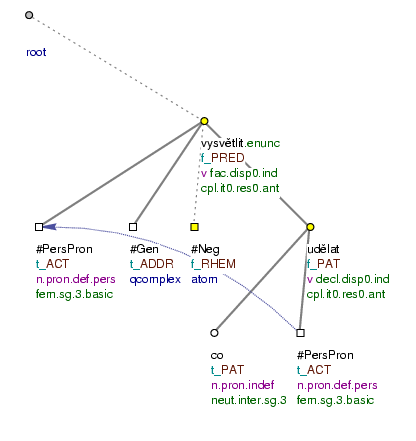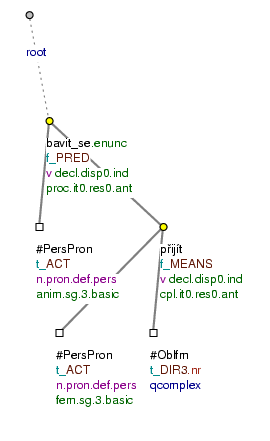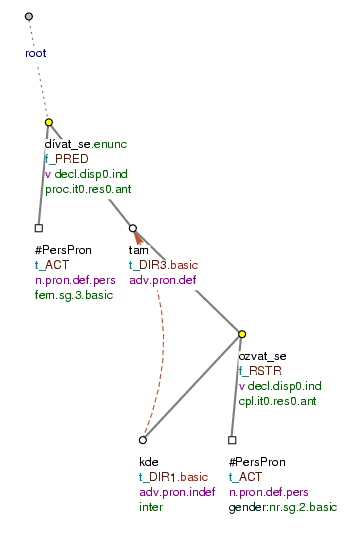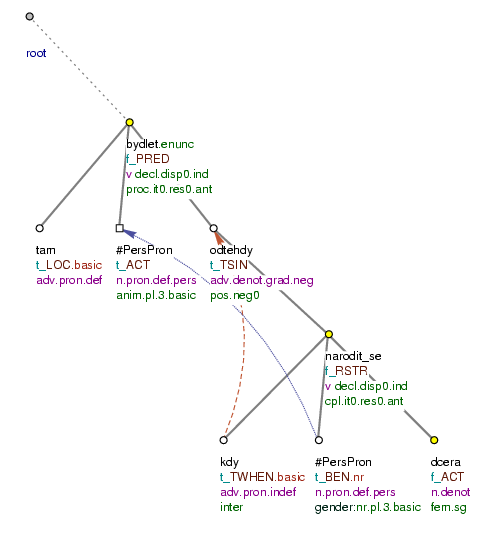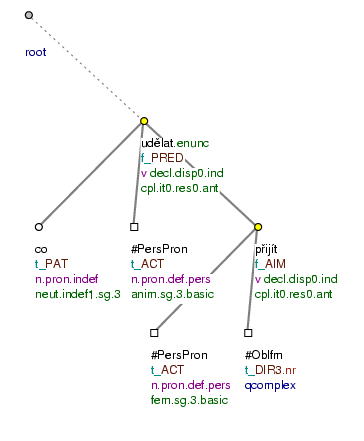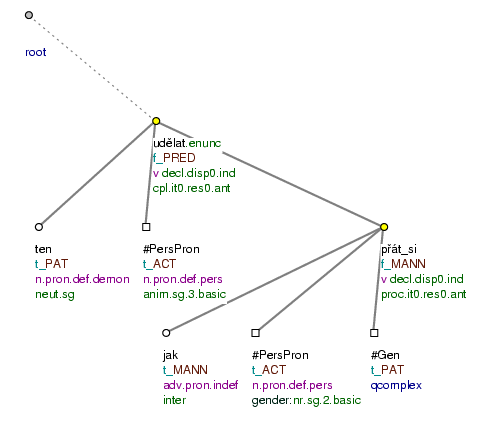Dependent clauses can be connected not only by means of conjunctions or relative elements but the governing clause can also contain a so called supporting expression. Supporting expressions are pronominal expressions referring to the following dependent clause which show the function (functor) of the dependent clause (by being used in a specific case or prepositional phrase); e.g.:
Znepokojil se <tím>, <že> nepřišla.MEANS (=He was worried by the fact (that.INSTR) she hadn't come)
jednání < o tom>, co.PAT budeme dělat.PAT (=lit. discussion on that what (we) were_going to_do)
If the function of the dependent clause is obvious even without the supporting expression, it is usually optional. Cf.:
-
Přemýšlel <o tom>, <zda> tam půjde.
PAT(=lit. (He) was_thinking about that whether (he) there will_go) -
Přemýšlel, <zda> tam půjde.
PAT(=lit. (He) was_thinking whether (he) there will_go)
If the function of the dependent clause is not obvious, the use of the supporting expression is obligatory. Cf.:
-
<Podle toho>, co.
EFFo něm víme.CRIT, to není vhodný kandidát. (=lit. According_to that what (we) about him know, it isn't good candidate)
-
Mluvil <o tom>, kdo.
ACTs ním spolupracuje.PAT(=lit. (He) was talking about that who with him cooperates)
The possibility or necessity of using the supporting element follows from the functor of the dependent clause (in the case of adverbial clauses) or from the surface form specification in the valency frame of the governing verb (in the case of content clauses).
!!! Valency frames do not contain the information regarding the optionality/obligatoriness of the supporting expression in the current version of PDT. The im-/possibility to express an argument by a dependent clause is not specified either.
Supporting expressions are not assigned a separate node in the tree (they are hidden). The reference to a supporting expression is in the a/aux.rf attribute of the effective root node of the dependent clause.
The effective root node of the dependent clause is assigned a functor depending on the supporting expression and the connective and depends on the effective root node of the governing clause.
Correlative pairs. A supporting expression + connective form a correlative pair. These correlative pairs can be divided into two groups depending on whether the second part is a relative pronoun (adverb) or a subordinating conjunction:
-
supporting expression + conjunction.
In this case, the whole correlative pair is hidden: the
a/aux.rfattribute of the effective root node of the dependent clause contains the references to both the supporting expression and the subordinating conjunction. -
supporting expression + relative element.
In this case only the supporting expression is hidden: the
a/aux.rfattribute of the effective root node of the dependent clause contains a reference to it. The relative element is always represented by a separate node.
Rhematizer adjacent to the supporting expression. If the governing clause contains a rhematizer (next to the supporting expression), it is represented as a left sister of the effective root node of the dependent clause in the tree; e.g.:
Přijde jen.RHEM <tehdy> , <když> mu ustoupíš.TWHEN (=He's only coming in case you give in to him)
The following subsections are devoted to the description of constructions with individual types of supporting expressions; these are also distinguished from constructions in which there are similar pronominal expressions but those are not considered supporting expressions. There are the following basic types of correlative pairs:
-
correlative pairs with the supporting expression "ten" (see Section 5.3.1, "Correlative pairs with the supporting expression "ten""),
-
correlative pairs with the supporting expression "takový" (see Section 5.3.2, "Correlative pairs with the supporting expression "takový""),
-
correlative pairs with pronominal locative/directional adverbs as supporting expressions (see Section 5.3.3, "Correlative pairs with pronominal locative/directional adverbs used as supporting expressions"),
-
correlative pairs with pronominal temporal adverbs as supporting expressions (see Section 5.3.4, "Correlative pairs with temporal pronominal adverbs as supporting expressions"),
-
correlative pairs with other pronominal adverbs as supporting expressions (see Section 5.3.5, "Correlative pairs with other pronominal adverbs used as supporting expressions"),
The most common supporting expression is the demonstrative pronoun ten. The pronoun ten is considered a supporting expression only if it precedes a content or adverbial clause (not a relative clause; for the distinction see Section 5.2, "Content vs. relative clauses"). If the pronoun ten precedes a relative clause it is a regular modification, represented by a separate node in the tree, and the effective root node of the dependent clause depends on it.
Examples of sentences with the supporting use of "ten":
Neuměla vysvětlit <to>, co.PAT udělala.PAT (=She wasn't able to explain what (lit. that what) she had done) Fig. 6.54
Bavil se <tím>, <že> přišla.MEANS (=He was amused by the fact that (lit. by_that that) she came) Fig. 6.55
Koupili dvě sady lega s <tím>, <že> dají.ACMP každému synovi jednu. (=They bought two sets of lego, planning to give one to each of their sons; lit. with that that they give...)
Přemýšlel <o tom>, <že> tam půjde.PAT (=He was thinking about going there; lit. about that that he...)
Unclear (homonymous) cases are analyzed with the help of context: the dependent clause either is a content clause and ten is a supporting expression, or it is a relative clause and ten is represented by a separate node in the tree. Cf.:
-
Přemýšlel o tom, kdo přijde. (=He was thinking about the one who was coming)
= He was thinking about the person who was coming.
With this interpretation, the dependent clause is a relative clause, its effective root node has the
RSTRfunctor and depends on ten. -
Přemýšlel o tom, kdo přijde. (=He was thinking about who was coming)
= He was thinking about (the question) whether this one or that one was coming.
With this interpretation, the dependent clause is a content clause, its effective root node has the
PATfunctor and depends on přemýšlet; the pronoun ten is a supporting expression in this case and is not assigned a separate node.
Correlative pairs "čím" -"tím". A special type of correlative pair with ten is the pair čím - tím, e.g.:
Čím.DIFF je.DIFF víno starší, <tím> je lepší. (=The older the wine the better)
This type of construction is described in Section 5, "Specific constructions with the meaning of "difference"".
Cleft structures. With so called cleft sentences, ten is not considered a supporting expression but it is rather a full lexical item, represented by a separate node in the tree; the relative clause depends on it and its effective root node has the RSTR functor.
Examples:
Je to.PAT Izrael.ACT, kdo brzdí.RSTR mírový proces (=It is Izrael who is slowing down the peace process).
Byli to.PAT českoslovenští občané.ACT, kteří hynuli.RSTR v koncentračních táborech. (=It was Czechoslovak citizens who died in the concentration camps)
The expression takový is a supporting expression usually when preceding dependent predicative and relative clauses, which are mostly introduced by jaký.
Examples:
Přidělili nám vedoucího <takového>, jaký.ACT se jim hodil.RSTR (=They gave us such a boss they found convenient for them) Fig. 6.56
Podpora jeho strany je <taková>, jaká.PAT opravdu je.PAT (=His party is getting the support it is getting) Fig. 6.57
Dostal jsem knížku <takovou>, jakou .PAT jsem chtěl.RSTR (=I got a book I wanted; lit. book such which (I) AUX wanted)
In those constructions in which takový precedes a relative clause (on its own, without modifying a noun), it is necessary to consider the possibility that it plays a role of a noun ( see Section 1.2, "Pronouns in the role of a syntactic adjective or noun"):
-
"takový" is a syntactic noun.
If takový plays a role of a noun, it is not hidden like supporting expressions and the relative clause depends on it.
Example:
Jsou tací.
ACT, kteří rádi hladovějí.RSTR(=There are such (people) who like to starve) -
"takový" is a syntactic adjective.
If takový plays a role of an adjective it is considered a supporting expression and the relative clause depends on a newly established (usually copied) node for a noun.
Example:
Máme hodně studentů, ale potřebovali bychom <takové> { student.
PAT} , kteří by byli.RSTRvzdělaní v nějakém ekonomickém oboru (=...we would need such students that would be educated in...)
Figure 6.56. The supporting expression "takový"
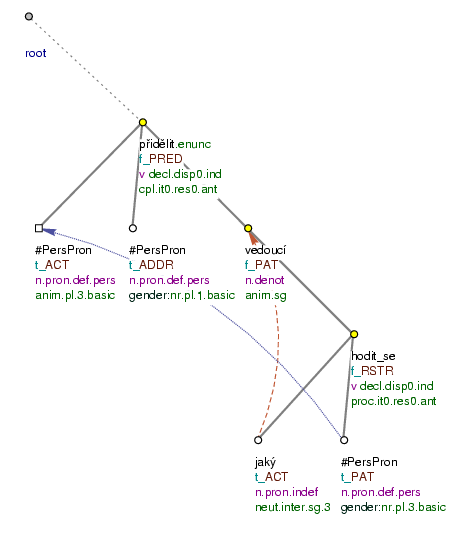
Přidělili nám vedoucího takového, jaký se jim hodil. (=lit. (They) assigned us boss such which REFL to_them was_convenient)
Figure 6.57. The supporting expression "takový"
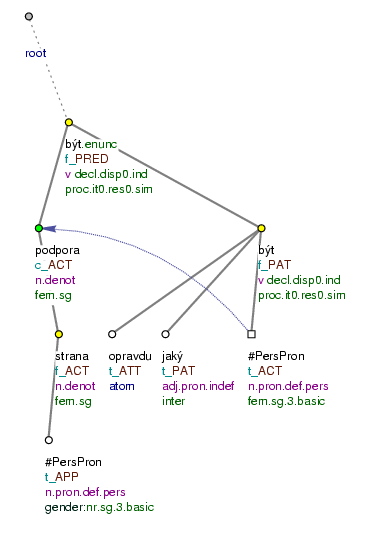
Podpora jeho strany je taková, jaká opravdu je. (=lit. Support (of) his party is such what (it) really is)
"Takový" is not a supporting expression. Takový is not considered a supporting expression when preceding a consecutive clause introduced by the conjunction že. In this kind of construction, the effective root node of the dependent clause has the functor RESL and depends on takový (see also Section 7, "Constructions with a dependent consecutive clause").
Examples:
Vedoucí je takový.PAT, že ho obdivujeme.RESL (=The boss is such that we admire him)
On je vedoucí.PAT takový.COMPL, že jim ho závidíme.RESL (=He is such a boss that we envy them)
5.3.3. Correlative pairs with pronominal locative/directional adverbs used as supporting expressions
Pronominal locative and directional adverbs (tam, odtud, tudy) form correlative pairs mainly with relative elements (kde, kam, odkud, kudy); only marginally with conjunctions. There are e.g. the following pairs:
-
pronominal locative/directional adverbs + relative elements:
-
the role of the pronominal adverb and the relative element is identical:
tam - kam (=there - where.dir) tam - kde (=there - where.loc) odtud - odkud (=from there - from where) tudy - kudy (=that way - which way) -
the role of the pronominal adverb differs from the role of the relative element:
tam - kudy (=there - which way) tam - odkud (=there - from where)
-
-
locative/directional pronominal adverbs in a correlative pair with a conjunction::
tam - co (=there - that) tudy - co (=that way - that)
Locative and directional pronominal adverbs in the governing clause are only considered a supporting expression if the role of the relative adverb in the dependent clause is the same or if the dependent clause is introduced by a conjunction. Then, the effective root node of the dependent clause depends on the effective root node of the governing clause and is assigned a locative or directional functor (see Section 4, "Locative and directional functors").
Examples:
Šel jen <tam>, kam.DIR3 ho pozvali.DIR3 (=He only went (there) where he was invited) Fig. 6.58
Díval se <odtamtud>, odkud.DIR1 se vždycky dívám.DIR1 já. (=He was looking from the same place (which) I always look from) Fig. 6.59
Šel <tam>, kam.DIR3 ho nohy nesly.DIR3 (=He went (there) where his legs took him)
pozvánka <tam>, kam.DIR3 nikdy nepojedeme.DIR3 (=an invitation to a place (lit. there) which (lit. where) we'll never go to)
Viděl jsem ho <tam>, <co> jsem ho potkal.LOC minule. (=I saw him at the same place (lit. there what) I met him last time)
Figure 6.58. Locative and directional pronominal adverbs used as supporting expressions
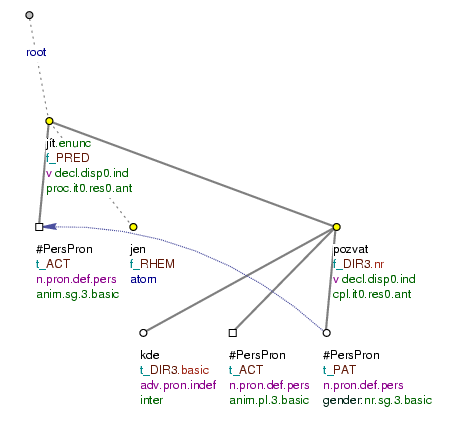
Šel jen tam, kam ho pozvali. (=lit. (He) went only there where (they) him invited)
Figure 6.59. Locative and directional pronominal adverbs used as supporting expressions
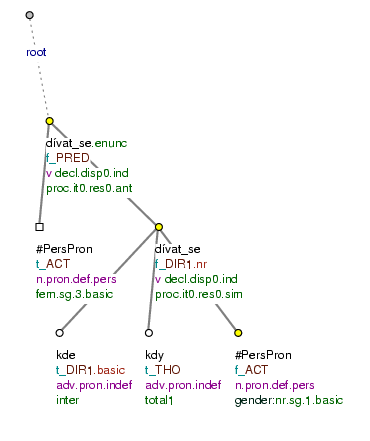
Dívala se odtamtud, odkud se vždycky dívám já. (=lit. (She) looked REFL from_there from_where REFL always look I)
The locative/directional pronominal adverb is not a supporting expression. If the adverbial expressions have different functions (in the governing and dependent clauses), the pronominal adverb in the governing clause is not considered a supporting expression; each adverbial expression is represented by a separate node. The effective root node of the dependent clause depends on the node for the pronominal adverb in the governing clause and is assigned the RSTR functor.
Example:
Dívala se tam.DIR3, odkud.DIR1 ses ozval.RSTR (=She was looking in the direction from which (lit. there from_where) she heard you) Fig. 6.60
Temporal pronominal adverbs form correlative pairs both with relative elements and conjunctions. One can find especially the following correlative pairs:
-
temporal pronominal adverb + relative element:
-
the function of the pronominal adverb and the relative element is identical:
tehdy - kdy (then - when) dotehdy - dokdy (=until_then - until_when) odtehdy - odkdy (=from_then - from_when) potud - pokud (=until_then - until_when) -
the function of the pronominal adverb differs from the function of the relative element:
odtehdy - kdy (=since_then - when) dotehdy -kdy (=until_that_time - when)
-
-
temporal pronominal adverb + conjunction:
tehdy - když (=then - when) odtehdy - když (=since_then - when) dotehdy - když (=until_then - when) předtím - než (=before - than) poté - co (=after - that)
Temporal pronominal adverbs in the governing clause are only considered a supporting expression if the role of the relative adverb in the dependent clause is the same or if the dependent clause is introduced by a conjunction. Then, the effective root node of the dependent clause depends on the effective root node of the governing clause and is assigned a temporal functor (see Section 3, "Temporal functors").
Examples:
Šli tam <tehdy>, kdy.TWHEN už tam nikdo nebyl.TWHEN (=They went there (then) when nobody else was there) Fig. 6.61
Bydleli tam <odtehdy>, odkdy.TSIN jim to bylo dovoleno.TSIN (=They lived there from the time (lit. since_then since_when) they were allowed to) Fig. 6.62
Udělala to <předtím>, <než> šla.TWHEN do nemocnice. (=She did it before (than) she went to the hospital)
Navštívíme vás jen <tehdy>, <když> nás pozvete.TWHEN (=We only visit you (in that case) if you invite us)
naše pozvání jedině <tehdy>, <když> vy pozvete.TWHEN nás (=our invitation only in case (lit. then if) you invite us)
The supporting expression "poté". Also the expression poté is considered a supporting expression with a temporal meaning. If co forms a correlative pair with poté it is considered a subordinating conjunction (it introduces an adverbial clause; see also Section 5.2.1, "Dependent clauses with the connective "co"").
Example:
Odjela <poté>, <co> všechno vyřídila.TWHEN (=She left after (that what) she arranged everything)
The correlative pair poté - co, but also other correlative pairs, are sometimes part of collocations like: krátce předtím, než (=short time before..); dva dny poté, co (=two years after...). In accordance with the rules in Section 11.3, "Mutual relation of two or more locative/directional or temporal modifications", the dependent clause can also modify preceding temporal modifications (which is a nominal phrase in the accusative or adverb). Cf.:
-
Odjela dva měsíce.
TWHEN<poté>, <co> porodila.TWHEN(=She left two years after she gave birth)The dependent adverbial clause introduced by the correlative pair poté -co modifies the temporal modification dva měsíce (cf. Fig. 6.63).
More examples:
Vrátila se 5 minut.TWHEN <poté> , <co> Jirka odešel.TWHEN (=She came back 5 minutes after Jirka left)
Odjela dva měsíce.TWHEN <od toho> , kdy.TWHEN porodila.TWHEN (=She left two months after she gave birth).
Figure 6.61. Temporal pronominal adverbs used as supporting expressions
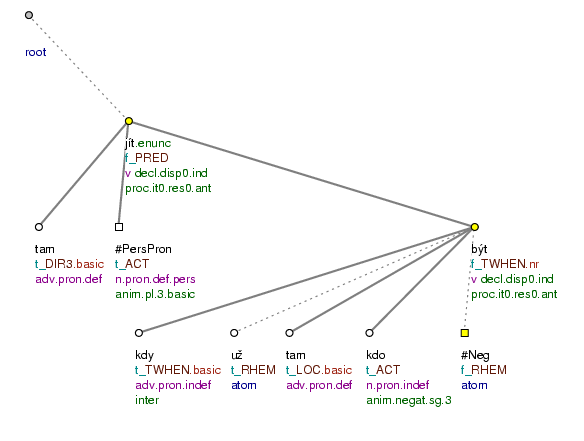
Šli tam tehdy, kdy už tam nikdo nebyl. (=lit. (They) went there then when already there noone not_was)
Figure 6.62. Temporal pronominal adverbs used as supporting expressions
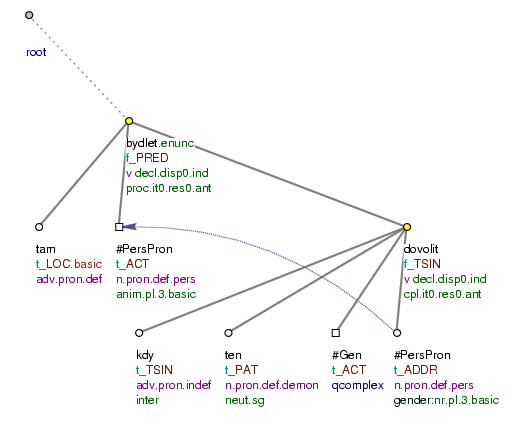
Bydleli tam odtehdy, odkdy jim to bylo dovoleno. (=lit. (They) lived there since_then since_when them it was allowed)
Figure 6.63. "Poté" used as a supporting expression
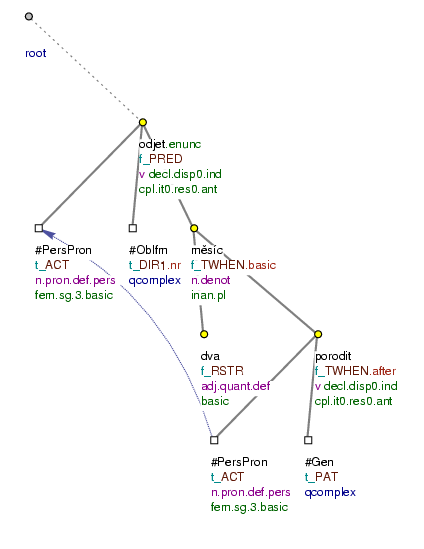
Odjela dva měsíce poté, co porodila. (=lit. (She) left two months after_that that (she) gave_birth)
The temporal pronominal adverb is not a supporting expression. If the dependent clause is introduced by a relative adverb and the function of the adverbial expressions in the governing and dependent clauses is different, the pronominal adverb in the governing clause is not considered a supporting expression. Each pronominal expression is represented by a separate node. The effective root node of the dependent clause has the RSTR functor and depends on the node for the pronominal adverb in the governing clause.
Example:
Bydleli tam odtehdy.TSIN, kdy.TWHEN se jim narodila.RSTR dcera. (=They lived there since the time (=since_then when) their daughter was born) Fig. 6.64
A range of other pronominal adverbs forming correlative pairs with relative elements and conjunctions are considered supporting expressions. It concerns especially the following pairs:
-
pronominal adverb + relative element:
tak - jak (=so - how) tolik - kolik (=so_much - how_much) tolikrát - kolikrát (=so_many_times - how_many_times) -
pronominal adverb + conjunction:
proto - aby (=apprx. in_order - to) proto - že (=apprx. so - that) tak - aby (=apprx. so - to) tak - že (=so - that) tehdy - kdyby (=then - if)
Correlative pairs: pronominal adverb + relative element. In these correlative pairs, the pronominal adverb (the supporting expression) has the same function as the relative element in the dependent clause).
Examples:
Udělal to <tak>, jak.MANN sis přál.MANN (=He did it as (lit. so how) you wished) Fig. 6.66
Dostal <tolik>, kolik.PAT chtěl.PAT (=He got as much as he wanted)
Correlative pairs: pronominal adverb + conjunction. In these correlative pairs, the conjunction introduces the dependent clause (a content or adverbial clause; not a relative clause) the function of which (expressed by the functor of its effective root node) is clearly given by the pronominal adverb in the governing clause for which it is the only role it plays, i.e. to refer to the dependent clause.
Examples:
Udělal něco <proto>, <aby> přišla.AIM (=He did it for her to come) Fig. 6.65
Pracoval <tak>, <aby> nikdo nic nenamítal.MANN (=He worked (properly) so that noone could have any objections)
Mohla by jet <tehdy>, <kdyby> nebyla nemocná.COND. (=She could go (in that case) if she weren't ill)
NB! The adverbial expressions tolik (=so_much), natolik (=to_such_a_degree), tak (=so) introducing dependent consecutive clauses are not considered supporting expressions; the effective root node of the dependent clause (with the functor RESL) depends on the node for such an expression (see also Section 7, "Constructions with a dependent consecutive clause").
